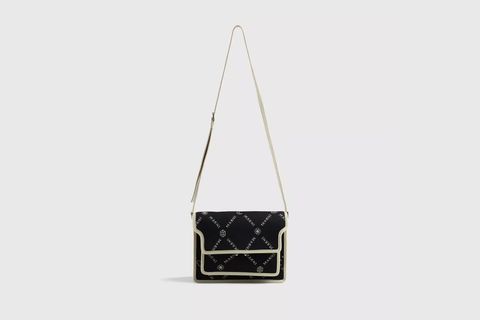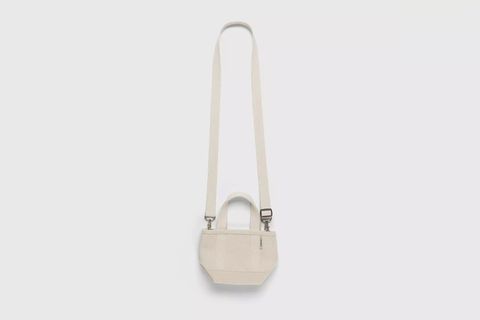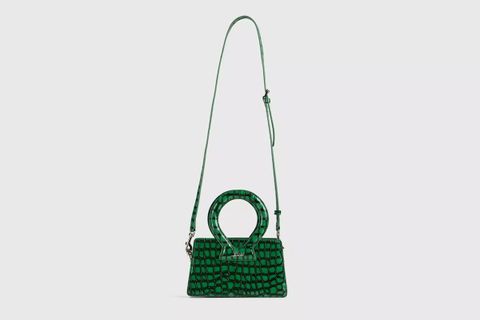How Men’s Handbags Took Over the World
Be it on runways, in fashion media, or on the streets, bags for men are having a moment. While briefcases and backpacks never really fell out of favor, the last few years have seen accessory styles usually reserved for women get co-opted by men. From top handle purses to mini crossbody mini, it seems that no silhouette is off bounds.
Market research company NPD Group revealed that in the US, men’s and unisex handbag sales had increased by a staggering 700% in 2021 when compared with 2018. Highsnobiety predicted this shift back in 2019, while Vogue recently reported that handbag sales are giving sneakers a run for their money on the resale market. But why the sudden interest?
The rise in gender fluidity has certainly played a role, as menswear has adopted traditionally femme items including skirts, heels, and nail polish. For eons, women have hauled their belongings in bags of all shapes and sizes, and now men are allowed in on such practicality. What’s more, bags can instantly elevate a fit.
It’s also not just about freedom of expression. Handbags are the backbone of luxury fashion houses’ revenues. In 2018, Sanford C. Bernstein, an investment research company, reported that handbags make up around 40% of a luxury brand’s yearly profits.
To understand how we arrived here is to know the history of men’s bag trends. And as history would have it, bags have been a men’s game all along.
From Antiquity to the Renaissance
Bags have been integral to the development of human civilization, as they’ve helped people gather loose items for easy transport. It’s believed that hunter-gatherers may have used proto-bags made of animal skins and plant fibers, yet it was in the Middle Ages when they became an accessory du jour. The word itself dates back to around 1200 CE to the Norse baggi, meaning “pack” or “bundle.”
In ye olde times, the girdle pouch was the “It” bag of the day. First adopted by men and later women, the small leather pouch hung from a belt or girdle at the waist and was used for holding valuables. But the pocket’s advent at the end of the Middle Ages pushed the humble girdle pouch out of fashion.
The Renaissance brought more trends, including Elizabethan swete bags, which took from the girdle pouch’s basic design. Worn by the aristocracy, the ornately embroidered bags were filled with sweet-smelling items such as herbs and dried flowers to ward off foul odors during a time when personal hygiene was lacking. As with the it-bags of today, swete bags were a sign of status and wealth.
Another notable invention from this time was the humble satchel, but it was mostly worn by schoolchildren. Bags began to split along gender lines during the Renaissance — women’s designs boomed while men’s bags entered a lull period.
Post-Industrial Innovation
The Industrial Revolution led to the rise of passenger rail travel in the first half of the 19th century and brought demand for sturdy bags. Thus, the modern briefcase was born in the 1850s.
Simultaneously, there was a need for lightweight luggage as the trunks of yore — which required a porter’s assistance — were unwieldy. The carpet bag, immortalized on screen in Mary Poppins, was created en masse as inexpensive personal baggage which was light enough for passengers to carry themselves. Originally made from rugs, carpet bags later served as the design inspiration for modern carry-alls.
The wartime period of the latter 19th and early 20th centuries was also a boon to innovation. In 1878, United States Army Colonel Henry Merriam received the patent for his so-called knapsack. Although people had carried goods on their backs for millennia, Merriam designed the prototype of the modern-day backpack. His design was cumbersome and ultimately discarded, but in the next half-century, a series of constructions by several inventors ultimately led to the backpack we know today.
The World Wars also gave us German bread bags, which featured straps attached to belts, making them an early version of today’s beloved belt bag. Although these military styles weren’t trends upon their inception, they became so after influencing civilian fashion later on.
Men’s Fashion Embraces Bags
By the early 20th century, most of the bag styles we know and use today had already been invented. But innovation came again in the 1980s, with the popularization of sports and wellness leading to a rise in fitness-focused bags made from synthetic materials like nylon. Fanny packs — originally designed mid-century for hikers and downhill skiers (and very reminiscent of the earlier girdle pouch) — proliferated and allowed for hands-free style. Adweek even named it the best product of 1988. Duffel bags also rose in prominence during the decade as an update on the carryall.
As fashion is wont to do, the 1990s saw the pendulum swing the other way. Style was so understated that bags as fashion accessories for men became practically non-existent. This is when public opinion on men’s bags regressed to the cringeworthy “murse” era. Thanks to a couple of primetime plot lines that saw an entire episode of Friends dedicated to lampooning Joey’s new bag, while Jerry Seinfeld adopted a “European carry-all” on Seinfeld, bags for men were as good as dead and buried.
Despite the fear of men’s bags lingering well into the aughts — 2009’s The Hangover made a punchline of the crossbody bag — trends in men’s bags finally made their way back, albeit in a low-key way. Alt-boys of the era eschewed backpacks for the nonchalant cool of messenger bags — invented 150 years earlier for postal workers and yet another variant of the satchel — complete with pins of their favorite bands. Meanwhile, indie sleaze hipsters favored roomy tote bags that communicated vague environmental concern, while managing to fit a six-pack of PBR. A win-win.
Streetwear Reigns Supreme
Streetwear’s ascent into luxury fashion in the 2010s brought a complete shakeup of the industry as we knew it. Where high fashion once dictated trends from the top down, the script was reversed and major trends began to form on the street first.
Early in the decade as men’s fashion leaned into sportswear, the backpack took center stage. In all fairness, backpacks never really went anywhere, but they were finally having their day in the sun, or rather, on the catwalks.
The sports theme continued with belt bags — or the second coming of the fanny pack — in the latter half of the decade. Their ubiquity in high fashion — as well as similarly sporty side bags — is testament to the power shift that defined the era. Nowhere was this better illustrated than in Louis Vuitton’s seminal collaboration with Supreme for Fall/Winter 2017. This melding of worlds set the stage for the expansion of menswear style codes we see today.
Disrupting Menswear
Nowadays, it seems that anything goes, but particularly timely is the adoption of traditionally female bag styles in menswear, as seen in Kim Jones’ reinvention of the Saddle bag at Dior, and Hermès’ introduction of the Rock, the first Birkin for men. Meanwhile, brands like Telfar and Luar have popularized genderless mini bags, while male celebrities are donning handbags in increasing numbers.
The huge rise in men's bag sales confirms it’s more than a passing micro-trend, as the limitations of menswear continue to be shed. And with bags fetching just as much, if not more, than footwear or other items on the resale market, the commercial gains will surely keep them in the spotlight. The history of men’s bags may be long, but it’s not as developed as women’s, making it high-time for the guys to play catch up.


